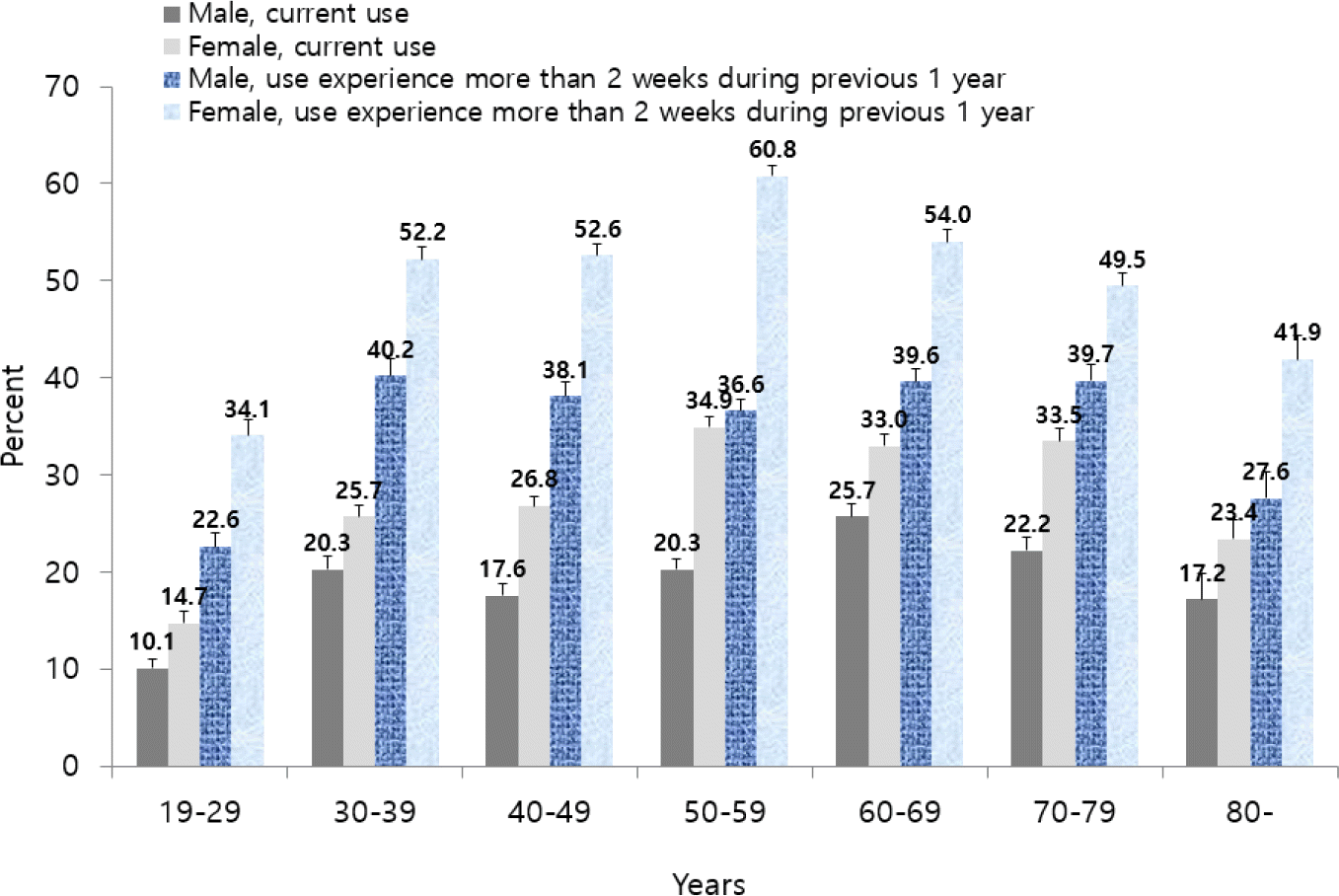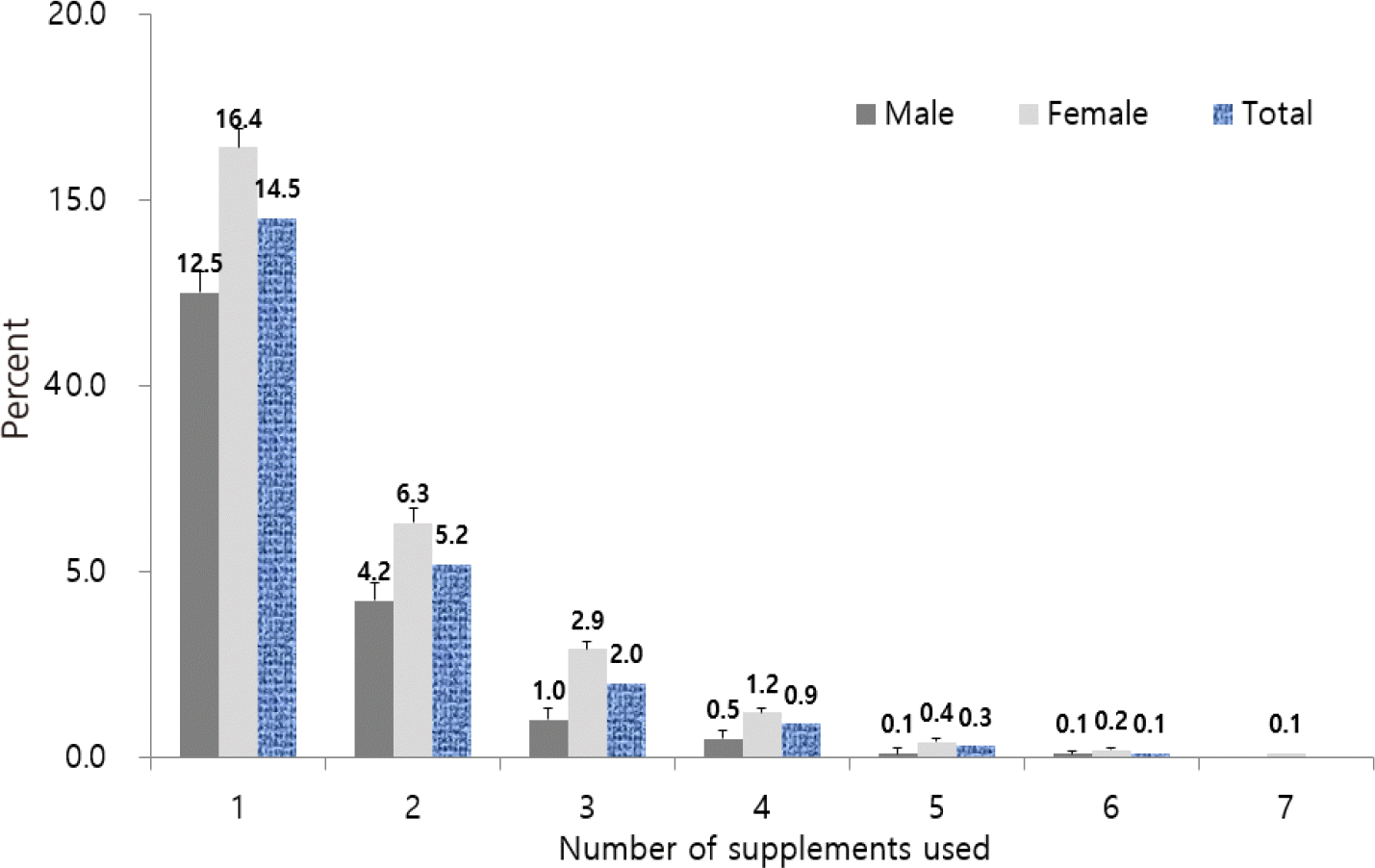Abstract
Background
The consumption of dietary supplements is increasing in Korea. The aim of this study is to assess the prevalence, types, and trends of dietary supplement (DS) use in Korean adults.
Methods
We analyzed the Nutrition Survey data of Korean aged 19 years old or older from the 2015 Korea National Health and Nutrition Examination Survey. Two thousand and six hundred twenty one men and 3,324 women totaling 5,945 adults were included. The prevalence of DS use was calculated by two methods, i.e., consumption experience of more than two weeks during previous one year and current consumption. Each reported DS in the one day 24 hour recall was coded based on ingredients according to the 2016 Korean Food and Drug Administration Notification.
Results
The prevalence (standard error) of current DS use was 18.4% (1.2) for men, 27.4% (1.1) for women. Those with DS use for longer than two weeks during previous one year were 35.2% (1.5), and 50.4% (1.2), for men and women respectively. Multivitamin mineral supplement (89.6/103 persons) was the most frequently consumed DS in Korean adults followed by vitamin C (66.2/103 persons), omega 3 fatty acid (49.5/103 persons), Panax ginseng (27.3/103 persons), and probiotics (22.2/103 persons) in listing.
Go to : 
References
1. Ministry of Health and Welfare. 2016 Korea Helath Statistics II. 2017.
2. Korea Agency of HACCP Accreditation and Services. 2017 Korea domestic market trend analysis of the dietary supplements use. 2017.
3. Yi HH, Park HA, Kang JH, Kang JH, Kim KW, Cho YJ, et al. What types of dietary supplements are used in Korea? Data from the Korean National Health and Nutritional ExaminationSurvey 2005. Korean J Fam Med. 2009; 30(12):934–43.
4. Park HA. Top 10 dietary supplements of Korean adults from the 4th Korea national health and nutrition examination survey. Korean J Fam Med. 2011; 32(4):263–6.

5. Korea Food & Drug Administration. Manual for KFDA notification (No. 2016–143) Health Functional Food. 2016.
6. Li K, Kaaks R, Linseisen J, Rohrmann S. Consistency of vitamin and/or mineral supplement use and demographic, lifestyle and health-status predictors: findings from the European Prospective Investigation into Cancer and Nutrition (EPIC)-Heidelberg cohort. Br J Nutr. 2010; 104(7):1058–64.

7. Korea Food & Drug Administration. Recognition on the functionality of ingredients of the health fuctional food. 2016.
8. Age-Related Eye Disease Study 2 Research Group. Lutein + zeaxanthin and omega-3 fatty acids for age-related macular degeneration: the Age-Related Eye Disease Study 2 (AREDS2) randomized clinical trial. JAMA. 2013; 309(19):2005–15.
9. National Evidence-based Healthcare Collaborating Agency. The clinical effectiveness of glucosamine and chondroitin therapy in treating patients with osteoarthritis. 2010.
10. Kim M, Lee Y, Park K. Vitamin and mineral supplement use among korean adults: baseline data from the trace element study of Korean adults in yeungnam area. Nutrients. 2018; 10(1):E50.

11. Rock CL. Multivitamin-multimineral supplements: who uses them? Am J Clin Nutr. 2007; 85(1):277S–9S.

12. Lin JR, Lin YS, Kao MD, Yang YH, Pan WH. Use of supplements by Taiwanese adults aged 19-44 during 2005–2008. Asia Pac J Clin Nutr. 2011; 20(2):319–26.
Go to : 
 | Figure 1.Prevalence of dietary supplements use in Korean adults according to sex and age.a
|
 | Figure 2.The number of dietary supplements used in Korean adults according to sex and age.a
|
Table 1.
Prevalence (per 1,000 persons) of dietary supplements usage categories by Korean adults in 2005 and 2015a
Table 2.
Prevalence (per 1,000 persons) of dietary supplements usage categories by Korean adults by sex and age groupsa




 PDF
PDF ePub
ePub Citation
Citation Print
Print


 XML Download
XML Download